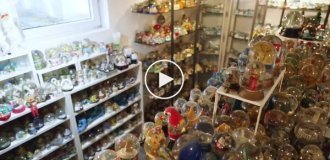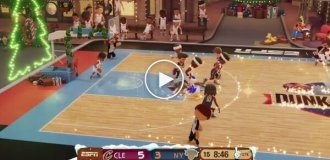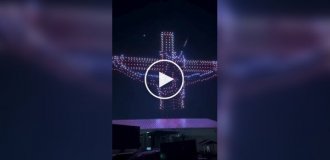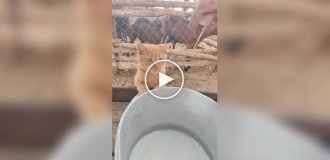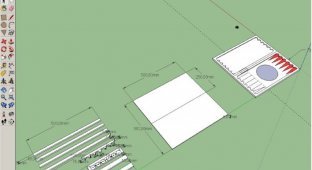Air hockey - do it yourself (46 photos + 1 video)
All fans of the popular game air hockey should like this post. One craftsman decided to please his son, who loves active board games. He made an air hockey table with his own hands. Let's take a look at his creation.

1. Air box. For the bottom of the air box we need 9 mm plywood, and for the top 4 strips of laminate flooring. The size of the box will be 1210x770 mm. Cut the required piece of plywood slightly larger than the size of the laminate (2-3 mm).

2. We connect the laminate strips together “into a rigid hook” provided by the plates. By the way, the laminate was not chosen by chance. Before this, there were thoughts of making a base from plywood, boards, furniture board, chipboard/fibreboard/MDF. But all were rejected due to low strength, softness of the material and suspicion of damage during drilling (the holes must be small and even!).

3. Mark the grid for drilling holes. We retreat 30 mm from each edge (this is the size of each side) and another 10 mm in order not to make extra holes at the side. The pitch between the holes was 20 mm.

4. Take a drill and drill about 2200 holes. The diameter of each hole is 1.5 mm. This is the most time-consuming and tedious operation when building a table. She ate about 4 hours of my life and four drills. I used 7 drills in total (they quickly became dull). I did everything in the bathroom, because it’s a huge mess (because I’m too lazy to clean it up later). Then I used an awl to widen all the holes on the back of the laminate.

5. I bought two 45x15 3m slats and sawed them into 4 parts (strictly according to the size of the plywood). These will be the sides of the air box.

6. We drill holes in the plywood (it is necessary, otherwise it will crack) and slats and place it all on the bottom with screws (you can nail it without drilling, but then you need to bite off the sharp end of the nails with wire cutters). In general, you will have to drill a lot here, so you will dream about the drill for a very long time. An anecdote on the topic: Today a neighbor knocked on my door at 3 am... Out of fear, the hammer drill almost fell out of my hands...

7. Electronics. We rummage through various computer junk and find 6 fans of varying power and a power button.

8. We also take the power supply from the old scanner. PSU characteristics: 12V 1.25A.

9. We sum up the consumption of all fans 0.25+0.22+0.22+0.12+0.12+0.12=1.05A. Yeah, there’s still room for lighting the gates with LEDs – that’s good!

10. Mark the fan holes and places for the mounting screws. We drill holes for fans and holes for mounting these fans.

11. Kote’s youngest son came to help.

12. File the edges of the holes and attach the fans. Long stripes on the plywood indicate the joints of the laminate sheets.

13. Since the structure is heavy and there must be space at the bottom of the table for air suction, I bought 5 rubber feet (door stops). They are made of very durable rubber and will help keep the table stable. The photo shows a leg with a screw threaded through it.

14. Attach the switch and connect the wires from the power supply to it.

15. Place the fan wires on the terminals.

16. We bring out the wires to the gate and glue the LED strip. We solder and check. Fill the solder with a glue gun.

17. We saw the remaining part of the 45x15mm plank into 9 pieces and fasten it from below with screws along the seams of the laminate. We also place the rubber feet on the screws from below and secure them from the inside with a nut and a locknut. This is the picture we get. The power supply wire enters the table in the lower right corner.

18. Take regular sealant (I use transparent plumbing sealant) and coat all the cracks along the edges, as well as the fans along the edge. We also glue the dangling wires and the power supply wire to the plywood with a glue gun. “Have you sealed the wheel? - Yeah, I glued it all night. The owner of the glue will come in the morning. ©Boomer"

19. It turns out like this.
[img]https://cn13.nevsedo
ma.com.ua/photo/23/3/hokkey-I.jpg[/img]
20. We buy a side rail 30x15 mm 2mx2 pcs. and cut it into the required parts (strictly to the size of the plywood) and leave space for the gate. We connect the laminate and place it on the table, having previously coated the slats attached to the plywood with sealant on top (we also coat all 9 supports under the seams of the laminate). We drill holes through this whole hamburger and fasten it with screws.

21. For the beauty and strength of the side, I took two mirror-polished aluminum corners 30x15 mm, 2 meters long. We saw it.

22. Let's try it on. By the way, on the left in the photo is an excellent device for the knees - I recommend it.

23. Senior mate.

24. Next, take an adhesive film of a similar color.

25. And glue it around the perimeter. There is a margin of 1.5 cm at the bottom, 0.5-1 cm at the top.

26. It turns out like this.

27. The plank and film will be on top with double-sided tape (it doesn’t really stick to plywood and wood, but a corner will hold it in place).

28. And we seal it from below with a furniture bracket.

29. That's it.

30. General view from below.

31. Attach the metal strips to the sides.

32. The children said ready, took the table away, and demanded bats and a puck. Let me play a little.

33. Gate. We cut the plywood into several parts.

34. Connect with a clamp, drill holes and screw in screws.

35. Assembling the gate. Let's try it on the table.

36. General view with the gate.

37. Illumination of the gate from the inside in the dark.

38. A closer look at the gate design.

39. When checking the goal, when the disc hit the goal hard, it bounced off the soft wood (plank) and flew back onto the table. To eliminate the defect, use double-sided tape to glue the remaining aluminum strip to the inclined rail immediately behind the gate.

40. We glue the same film onto the gate. We cut off unnecessary things.

41. We get two such devices. I didn’t specifically cover the inside with film, because... there will be constant wear on the walls with the washer and the film will simply tear. Instead of the usual carpet, we see a colorful sofa in the background.

42. Attach the gate to the table. They are made with a “door” on top so that the washer can be easily reached. When the door is closed, it lowers onto a lock/travel limiter (a regular small screw inside the door). This “door” serves as a rebound for the puck. It is on this that the aluminum plate is fixed.

43. General view of the table.

44. Take bits and washers. I used a small CD and a lens cap as a washer.

45. The product is ready to eat!
 46. The actual gameplay (the children took it away at the stage of building the gate):
46. The actual gameplay (the children took it away at the stage of building the gate):
Production time: sketching a plan, thinking, purchasing everything you need - 2 days. Stay 2-3 hours in the evening Wed-Thu-Fri and two full days Saturday-Sunday. Those. completed in a week.
And, probably, the most worrying question for many is about money:
Sheet of plywood 9mm 1525x1525mm – 569 RUR. The rest will go towards a dollhouse for my daughter/mother.
Laminate flooring is left over from replacing the floor. There’s still some left – write to anyone who needs it in a personal message.
IKEA pencils - free. You really need a lot of them when applying the mesh.
Drills – 7 pcs. x 6 rubles = 42 rubles.
Reiki 2x79 rubles = 158 rubles.
Reiki 2x55 rubles = 110 rubles.
Fans – were removed from various faulty equipment or left over from PC repairs.
Rubber feet 5x79 RUR = 395 RUR.
Switch (small size) – 180 rub. I bought it a couple of years ago for a dollhouse.
Wire, terminals, clamps, glue stick, screws, staples - 100 rubles worth of little things.
LED strip 12V – 99 RUR. 4 more pieces left
and for a doll's house.
A can of sealant – 100 rubles. There's still a lot left.
Aluminum corner 689 rub.2 = 1378 rub.
Double-sided tape – 60 rub.
Film – 119 rub. 1 meter. More than half was not used.
Bits 2x125 rubles = 250 rubles. It turned out to be quite difficult to find in stock in Moscow. I know where to buy - write in a personal message.
An 8 cm CD was initially tested as a washer, but was killed on the second day (it broke). Now we use the lens cap.
Help for a son x 2 pcs., for a daughter x 1 pc. – priceless.
Total: 3560 rub.
The cheapest air hockey of this size in stores starts from 5-5.5 thousand.
Summary:
The fan power is quite enough for the CD to glide smoothly. The lens cover does not hold up very well, but for heavier “pancakes” you need more fans. Soon I will buy a real air hockey puck and test it on it.
In fact, the cat was full of information on building air hockey with your own hands on the Internet, so basically I came up with everything myself.
Naturally, you can save on materials, and it will cost you much less. For example, instead of mirror slats at 700 rubles per piece. you can nail a strip of tin to the sides, or find plywood in the trash (saving 1378 + 569 = 1947 rubles), but I wanted to get a good, high-quality and beautiful product, which is what I achieved.
That's all I wanted to say. Thank you for your attention!

